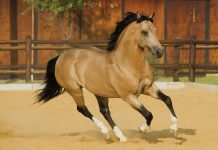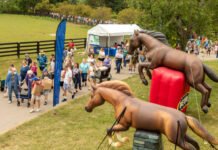A trail class is a ridden class in which you and your horse negotiate around seven obstacles while being judged. The obstacles are similar to things you might meet out on a trail ride: a gate, a bridge and poles (a substitute for logs or branches). To do well in the class, your horse has to react calmly to the obstacles she must walk, jog or lope over or around.
With the help of your trainer or parents, set up a few trail class obstacles at your barn so you can practice them. Grab a few poles and make a fake bridge out of a sheet of ¾ inch outdoor-quality plywood. If either of your parents is handy with a saw, perhaps someone can build you a gate out of wood and a loop of rope. You can find gate design plans online or on western forums.
We asked western trainer Missy Jo Hollingsworth of Saddle Lake Equestrian Center for some tips about how young riders like you can do well in a trail class.
“First of all, riders should read the rules of the particular class they want to enter,” says Missy Jo. “If you visit the American Quarter Horse Association’s website at www.aqha.com, you can download a rulebook that tells you what you should know about trail classes.
“There are sample courses on the site, so you can set up a great practice course at home.
“Practice is the key to doing well at a show,” says Missy Jo. “I always say, practice does not make perfect, perfect practice makes perfect!”
Here are some tips from Missy Jo about trail classes:
1. Maintain the same speed and rhythm in the obstacles as you do in between the obstacles.
2. Your horse should be willing and confident around the course.
3. Always look toward the next obstacle so your body can take your horse there. When you look at an obstacle, your hips and thighs will turn slightly and they will help guide your horse.
Let’s watch as Missy Jo’s student, Maddie, practices a few trail obstacles on her American Quarter Horse, Radical Izzy.
Back Through
Some trail courses include a set of poles that your horse must back up through. It’s important that your horse listens to your legs and responds when you ask him to back up. Before you begin backing your horse, make sure she’s standing straight in between the poles and ask him to stand for a second or two before you cue him to back up. As she backs up, continue to keep her body straight; you don’t want her hips swinging and her back legs stepping over the poles. Keep some rein contact and ask for small, controlled steps.
Missy Jo asks Maddie to glance quickly down the back of her leg so she can see the obstacle as Izzy backs up.
Jog & Lope Poles
Set up three poles three feet apart and then practice jogging over them. Keep the same rhythm you had approaching the obstacle when you’re jogging over the poles.
“Don’t just do the obstacles over and over when you’re practicing,” says Missy Jo. “Work on your pace and rhythm on the rail too.”
You don’t want your horse to jog like a snail over the poles because she could trip and lose points. If you go too fast she could knock a pole and this could be counted against you too. Keep a fairly loose rein on your horse when you do jog poles. She should stay balanced without too much help from you.
Always aim for the middle of the poles.
Lope poles are set at around six feet apart. Often they are set up as a fan pattern (on a curve) so your horse must bend her body as she lopes over them. You may use slightly more contact over lope poles because your horse must be more collected.
If your horse is short-strided, aim for the section where the poles are closer together; if she’s long-strided, stay to the outside of the fan to get a good trip through the poles.
Bridge
Jog in a nice, consistent rhythm until you are a few steps away from the bridge. Some riders halt for a second or two before asking their horse to step on the bridge but if you’re horse isn’t rushing and you feel in control, simply slow down to a walk and step up on the bridge.
Keep your horse in the middle of the bridge.
“Steer straight,” advises Missy Jo.
What should you do if your horse steps off the bridge to the side? Whoops! Keep going—and the same goes for all of the obstacles.
“Don’t start over,” says Missy Jo. “Finish the obstacle to your best ability. There are no retries in a trail class.”
Gate
Ride up next to the gate and get as close as you can. You need to be able to reach the latch (usually a rope loop) without leaning.
“Some horses get anxious near a gate,” says Missy Jo. “Let your horse stand next to the gate for a while until she gets used to it. Don’t be in a hurry.”
Put your reins in your outside hand (leave the reins loose-ish to demonstrate that you have control of your horse) and grab the rope in your inside hand.
Ask your horse to back a few steps and then use your inside leg to ask her to move her hindquarters around so she’s facing the opening and ask her to walk forward. Once she’s through the gate, use your leg again to push her hindquarters around so you’re facing in the other direction and are parallel to the gate. You may need to push her over a bit with your outside leg so she’s close to the gate. Back a step or two, keeping your outside leg slightly behind the cinch to stop her hindquarters swinging out. Then replace the rope latch and ask your horse to walk forward.
When you’ve mastered all of the obstacles in your pattern at home, Missy Jo says to do the obstacles in a different order. Mix things up.
“Only practice trail courses that are appropriate for your level,” says Missy Jo. “Don’t over face yourself or your horse.
Thanks to Maddie, Izzy and Missy Jo Hollingsworth
www.missyjo.com.





